Don't wanna be here? Send us removal request.
Text
When vocals mattered in Kpop. Let's talk about MAMAMOO.
Back around 2018-2019 and subsequent years, when San Borja Park and GAM were filled with people dancing, Kpop even played on national TV morning shows, and the first bubble tea and Korean food shops were open, fans knew a wide variety of Kpop groups recognized for both their dancing and their voices (and to be honest, also for their visuals).
While many might think of BTS or TWICE (if we want to include a girl group) when I mention Kpop, today I'm here to talk about MAMAMOO.

A group made up of four women: Solar, Moon Byul, Whee In, and Hwa Sa, belonging at the time to a small company, RBW. Their name comes from the word "mama," which is usually the first word babies pronounce. With this, they wanted to represent the closeness and intimacy they seek to achieve with listeners through their music. They debuted in 2014 with their first album "Hello" and their promotional song "Mr. Ambiguous."
Although they quickly became known in Korea for their incredible voices and for breaking a bit with Korean beauty stereotypes, with some of them being considered "ugly" by the media, MAMAMOO managed to expand worldwide. With their album "Purple," they reached number 1 on the Billboard album charts.
With their song "gogobebe," MAMAMOO became widely recognized, at least in the Chilean Kpop scene (where I was immersed). Many groups of people learned the dance and performed it, as it was one of MAMAMOO's songs with the most captivating choreography until then. In fact, the "Gogobebe" Dance Practice with MinaMiyoung reached the top 3 in the list of most-viewed practice videos on YouTube in 2019.

Even so, MAMAMOO never abandoned the group's essence, where singing was their greatest strength. The mix of both powerful and soft voices allowed the members to create a harmonization full of colors.
The group has an extensive discography, but if you'll allow me to recommend a couple of songs: if you feel like crying, "I Miss You" from the album "Melting." And something a bit more upbeat: "Hip" from the album "Reality in Black," but only because it's iconic. I could spend a long time talking about this and recommending songs because there are so many, but it's time to stop.

You might consider me a hater of current Kpop because of my blog title (and i am), but with this, i want to say: bring back songs with the artists' true essence, bring back enjoyment and good voices in Kpop, where you could listen to a song and know which group it was from by its unique style, not so influenced by North American culture.
STAN MAMAMOO!
Or actually, bring back MAMAMOO!
4 notes
·
View notes
Text
A Female Musician You Need to Know: Hiromi.
A Female Musician You Need to Know: Hiromi
During a class, the professor asked if we knew of any female artists who don't sing. And even though I'm sure there are tons out there, it was actually pretty hard to come up with an answer.
In the music industry, where men tend to gain the most popularity, I feel the need to bring you a recommendation for a female musician whom I personally love very much.

Born in Hamamatsu, Shizuoka Prefecture in 1979, she started playing piano at the age of 6 and studied composition at the Yamaha Music School.
At 17, she performed with Chick Corea. In 1999, she entered the Berklee College of Music in Boston. While still a student, she signed with the prestigious jazz label Telarc and made her world debut in 2003 with the album "Another Mind." Since this album, Hiromi has garnered acclaim and performed with an impressive variety of musicians, including bassist Anthony Jackson, drummer Simon Phillips, guitarist David Fiuczynski, and drummer Lenny White.
While Hiromi has solo compositions, she also has various collaborative projects with other artists. One of her most recent projects is "Sonicwonderland," with bassist Hadrien Feraud, drummer Gene Coye, and trumpeter Adam O'Farrill. This project explores new musical frontiers, challenging conventional jazz boundaries. Hiromi dives into bold new sounds, mixing jazz, rock, funk, and other genres to create something totally unique and captivating.
The project already two albums out, and if I can indulge myself by recommending a song, I'm sure you'll enjoy, I'd say "Yes! Ramen!!" Aside from loving the title and the album cover, the song itself is just so, so good.

Although there's not much more I can say about Hiromi, beyond recommending her over and over, I'll allow myself one more indulgence: she is the composer of the soundtrack for "Blue Giant," an anime film released in 2023 about a young man who wants to be a great jazz saxophonist. She brought together around 30 musicians to create the music for this film.
And I almost forgot to say she has a Tiny Desk!
Without much more to add, I really hope you explore her music, and maybe we can start talking about more awesome female artists!
2 notes
·
View notes
Text
The Authentic Sound of Perfume: A J-Pop Phenomenon
Perfume is a Japanese techno J-pop girl group that formed in Hiroshima in 2001. The trio consists of Ayaka Nishiwaki (A-Chan), Yuka Kashino (Kashiyuka), and Ayano Omoto (Nocchi).

While the group debuted in 2002, it wasn't until 2006 that they fully embraced techno-pop. That year, they released "Electro World," which remains one of their most famous singles, followed by their first album, "Perfume~Complete Best~." This compilation of their best songs quickly topped Amazon's online sales charts, marking the beginning of their widespread success.
In 2008, Perfume released the album "Game", which became their first number one hit on the Japanese sales charts. This achievement earned them a Japan Record Award and led to their first national tour. The following year, in 2009, they performed at the prestigious Nippon Budokan, one of Japan's most important stages.

While Perfume's success within Japan was undeniable, the group began to expand internationally. This presented a challenge, as they aimed to introduce their music "as is" to a foreign market—a market that often makes it difficult for groups with musical styles outside the mainstream to gain traction, especially with the significant influence of the United States in the international music scene.
However, Perfume remained faithful to both their musical style and their performance approach. Their shows incorporate dance with technology, often featuring advanced projection mapping and synchronized visuals that seamlessly blur the line between human and machine. Each of the three members also maintains a distinct aesthetic, defining elements like their haircuts, stage costumes, and the specific vocal parts they sing. These unique group characteristics help new viewers easily identify and remember the group's name.
After extensive tours both within and outside Japan, and releasing numerous albums and singles (which I won't mention), Perfume made history in 2019 by performing at Coachella. They were the first J-pop girl group to grace such an important stage for American music culture and the music market.
Aguante Perfume!
- Antonia Pastene Arias
6 notes
·
View notes
Text
Hatsune Miku: The First Virtual Pop Diva
To begin, I must explain what VOCALOID is. It is a voice synthesis software application, capable of singing, developed by Yamaha Corporation. It allows users to generate a song simply by writing the lyrics and melody. Depending on which VOCALOID is used, the voice of the song will vary. In 2004, Crypton Future Media released their first Vocaloid with the software VOCALOID01, called Meiko.

Although Meiko, and later Kaito (2006), did not achieve great success, Crypton Future Media, in 2007, launched Hatsune Miku through the VOCALOID2 software (an update to the first version). Her name translates to "First Sound of the Future." Hatsune Miku was the first virtual vocal character and remains the most famous to this day.

She quickly went viral on a Japanese video-sharing platform (Nico Nico Douga), where users listened to the songs and created collaborative content. Starting from the original song, other users on the platform would create illustrations, 2D and 3D animations, and remixes, demonstrating the various possibilities of using the software for multimedia content creation.
After this initial success, various projects involving Hatsune Miku began, one of the most important being the release of her own video game, Hatsune Miku: Project Diva (2009) a rhythm game released by Sega for the PlayStation Portable, featuring songs such as 'World is Mine' and 'Levan Polka. That same year, Hatsune Miku made her first guest appearance at a concert (Animelo Summer Live), where she was projected on a 2D screen.

A few months later, on August 31, the “Miku FES'09 (Natsu)” took place, where Hatsune Miku performed as the first hologram singer. On March 9, 2010, Miku's first solo live performance titled “Miku no Hi Kanshasai 39's Giving Day” took place, becoming one of her most viral and visited concerts on the internet to this day.

Although the title of this blog is "Hatsune Miku: The First Virtual Pop Diva," her music varies in terms of musical genres. This is due to what I explained earlier: anyone can use the Hatsune Miku software and can use her voice to create the music they desire. Therefore, she is not only the first virtual singer and the first hologram singer, Hatsune Miku is a massification tool for music creation.

21 notes
·
View notes
Text

In my Media Arts class today, I did some pixel art and animated Mario turning into Hatsune Miku 🙏🏻
22 notes
·
View notes
Text
Why does Citrus damage the reputation of yuri anime?
Citrus is a manga written and illustrated by Saburouta, published in the Japanese magazine Comic Yuri Hime, and later adapted into an anime by Studio Passione. In this blog, I'll be focusing on the ANIME, as I haven't read the manga.
According to Wikipedia, it belongs to the drama, romance, and yuri genres. However, I would dare to say it has nothing romantic about it.
The story revolves around Yuzu, who transfers to a new (all-girls) school when her mother remarries. There, she meets Mei, the student council president, who touches her without consent during their first encounter.
Later, Yuzu is looking for her teacher when she finds Mei kissing him. I don't think it's necessary to mention that Mei is underage and he is HER TEACHER!
Really, what is this? The anime is barely one episode in and there have already been two scenes of abuse.
As the anime progresses, we see more scenes where Mei kisses Yuzu (again, without her consent), and let me tell you, I haven't even mentioned yet... that they are stepsisters.
Later, Yuzu starts developing romantic feelings for her stepsister Mei. And that's when new characters start appearing, they kiss, they touch each other, nothing else to say.
I'm writing this blog to vent my accumulated anger. How did Citrus become one of the most well-known yuri animes? I can't comment on the manga, but even the animation in the anime doesn't seem good enough to enjoy visually. I don't know if I'm missing something for Citrus to have a 67% 5-star rating on Crunchyroll with 15,919 ratings.
If anyone wants to explain to me what's so good about the Citrus anime to justify ranking it with more than 1 star, please do.
Stop sexualizing sapphic relationships in anime!

0 notes
Text
Suzumiya Haruhi no Yuutsu and the Global Spread of Light Novels
Suzumiya Haruhi no Yuutsu (涼宮ハルヒの憂鬱), The Melancholy of Haruhi Suzumiya or La melancolía de Haruhi Suzumiya, is a series of light novels written by Nagaru Tanigawa and illustrated by Noizi Ito. The novels were first published in The Sneaker, a seinen magazine by Kadokawa Shoten, starting in 2003, with the final volume released in 2020.
The series was adapted into an anime in 2006 with its first season, followed by a second season in 2009 and an animated film in 2010, all produced by Kyoto Animation. Additionally, it inspired adaptations into manga (2005) and video games, released between 2007 and 2009.
The success of Suzumiya Haruhi no Yuutsu is undeniable. By 2007, over 4.3 million copies of the first novel had been sold, and the tenth volume set records for light novel print runs. Globally, the series has reached approximately 16.5 million copies in print, with 8 million sold in Japan alone.

Although this anime was not the first adaptation of a light novel, it achieved such unprecedented success that it significantly boosted the consumption and adaptation of light novels into anime. Iconic series such as Toradora! (2008) and Sword Art Online (2012) followed in its footsteps, building on the momentum generated by Haruhi.
The anime adaptation of Suzumiya Haruhi no Yuutsu stood out for its innovative approach, with a non-linear storytelling structure, deeply memorable characters, and high-quality animation by Kyoto Animation. These elements captivated audiences, turning the series into a beloved production.
It became a cultural phenomenon, with the anime spreading worldwide. In the 2000s, dances and memes inspired by the series went viral online. In Japan, fans cosplay as the characters and performed the Hare Hare Yukai (first opening theme) in public spaces.

For these reasons, Suzumiya Haruhi no Yuutsu holds an important place in the popularization of otaku culture and the global spread of anime and Japanese pop culture.

Watch Suzumiya Haruhi no Yuutsu!
1 note
·
View note
Text
The Power of Animated Food
With this title, many might think I’m about to talk about Shokugeki no Souma or the iconic food scenes from Studio Ghibli films. Anyways, I wouldn’t be surprised if Dungeon Meshi also crossed your mind.
Dungeon Meshi, Delicious in Dungeon or Tragones y Mazmorras, is a manga series created by Ryoko Kui, published in the seinen magazine Harta. It was later adapted into an anime by Studio Trigger and distributed by Netflix, completing its first season with 24 episodes.
However, this time we won’t focus on the story or the plot behind Dungeon Meshi. Instead, we’ll delve into its remarkable portrayal of food and a little bit of biology.

Laios, one of the main characters in Dungeon Meshi, is essentially a dungeon biology enthusiast. Throughout the anime, whenever he encounters new creatures, he explains their characteristics, anatomy, and behavior. This not only helps us understand how to cook these monsters but also highlights Laios’ emphasis on the relationships between monsters that are necessary to maintain the ecosystem within the dungeon. He advocates for respecting and being grateful for the food they can consume there, avoiding unnecessary killings, as disrupting the balance could harm the entire ecosystem.
So, considering that they only eat monsters, would you try the food from Dungeon Meshi? Personally, I’d say yes. But honestly, I’m often unsure if I’d enjoy the taste or the texture. But, it’s the animation, colors, and art style that make me answer YES without hesitation. In this post, I’ll showcase some of the dishes (from the anime) that make me reconsider eating monsters:
1. Tentacle Gnocchi
A spaghetti dish made from tentacle tendrils, and a gnocchi variation of the same. Both are stir-fried with Giant Frog meat in olive oil, garlic, and chili.
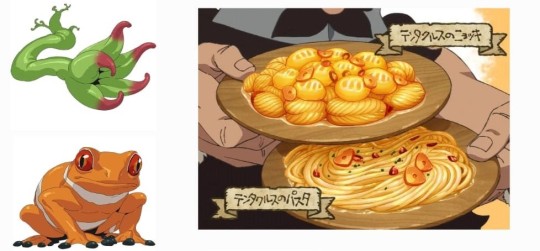
2. Exorcism Sorbet
A frozen version of their fourth dish, created during the process of dispelling ghosts. It’s made with water, a bit of salt, and sugar.
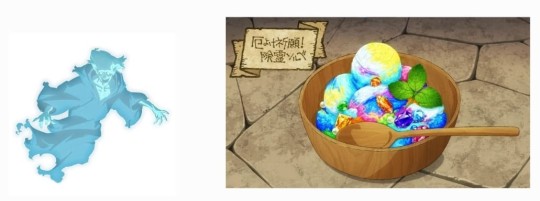
3. Boiled Mimic
Prepared by Senshi, this dish involves a mimic boiled in water with salt, as the name suggests.
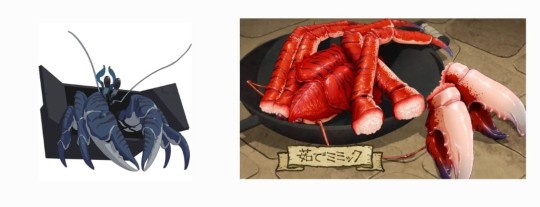
4. Mandrake and Basilisk Omelet
Made from Basilisk eggs, Basilisk bacon, and mandrake.
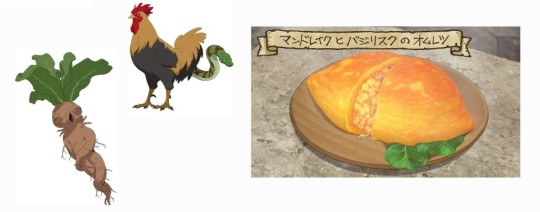
AND LAST BUT NOT LEAST!!! My favorite :3
5. Stone-Baked Cockatrice and Egg Ankake
This dish has cockatrice meat, seasoned and pan-fried with dryad fruit, mandrake fruit, and leaves. At the base of the dish is a layer of cooked barley inside a hollowed-out brick made from dungeon cleaner secretions. It’s topped with a cockatrice egg sauce and baked to perfection.
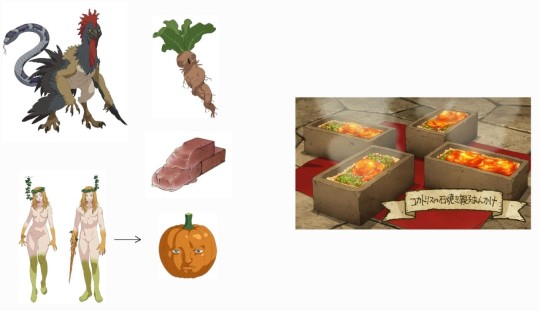
That would be my favorites. Would you try them?
Dungeon meshi… oh... Dungeon meshi.

2 notes
·
View notes
Text
Why I claim Tomoyo as part of the LGBTQ+ community: Tomoyo Daidouji and her one-sided love
Card Captor Sakura (カードキャプターさくら), also known as Sakura Card Captors in America, is a manga published in 1996 by Kōdansha in the monthly shōjo manga magazine Nakayoshi. It was written and illustrated by CLAMP and later adapted into an anime, which aired from 1998 to 2000, concluding with 70 episodes animated by MadHouse Studios.
Tomoyo Daidouji (大道寺 知世, Daidōji Tomoyo) is the best friend of our protagonist, Sakura. Throughout the series, Tomoyo is mainly responsible for designing Sakura’s costumes, adding variety and dynamism with each new card capture that Sakura undertakes. She always supports her friend and often mentions how she only wants the best for Sakura and for her to be happy.

From the very beginning, Tomoyo and Sakura are inseparable friends. Tomoyo frequently expresses how much she loves Sakura, how beautiful, brave, and incredible she is. However, I would like to discuss a few scenes or volumes of the manga where Tomoyo demonstrates her one-sided love for Sakura, sometimes without directly saying it.
In Volume II of the Card Captor Sakura manga, Deluxe Edition, and in Episode 11 of the anime, Tomoyo invites Sakura and Kero to her home. She struggles to open a box containing something very precious to her, and after resolving the issue with the involved Clow card, we see Tomoyo's "treasure," which turns out to be an eraser Sakura gave her the first time they met.
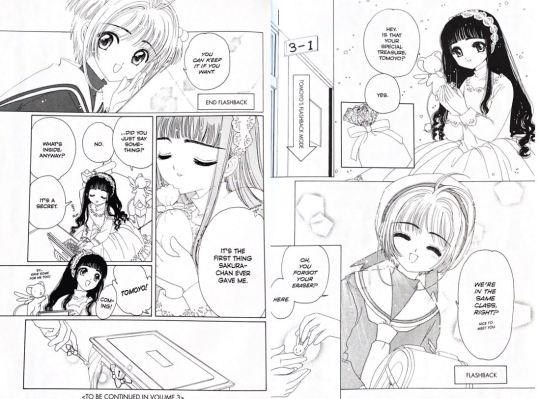
In another scene, Sakura, Tomoyo, and their classmates are shopping for materials to make teddy bears. It’s said that if you give a bear with your name on it to someone you love, they will reciprocate your feelings. In this context, Sakura asks Tomoyo if she’ll buy one, and Tomoyo, looking at Sakura (surrounded by petals and sparkles typical of love scenes in this genre), replies that there’s something that would make the person she loves happier than reciprocating; her greatest happiness is seeing that person be happy, even if it’s not with her.
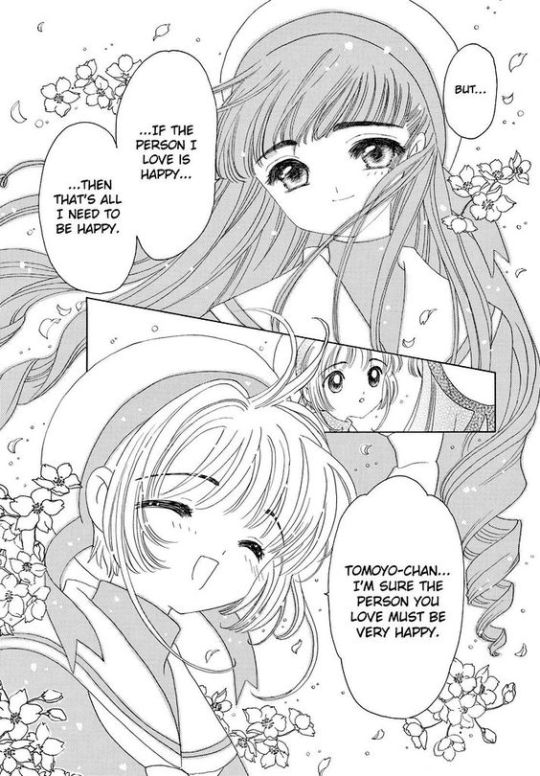
There are many moments like this where Tomoyo indirectly shows her unrequited love for Sakura.
But all of this leads us to the most important moment, where Tomoyo confesses her feelings for Sakura.
In the manga, this happens in in Volume I of Card Captor Sakura Deluxe Edition, and in the anime, it is Episode 10, the sports festival episode. Tomoyo tells Sakura that she loves her, and Sakura replies that she feels the same. However, Tomoyo mentions that her "I love you" has a different meaning than Sakura’s, making it clear that Tomoyo loves Sakura romantically and not just as a friend. Sakura does not hear what Tomoyo said, and when she asks about it, Tomoyo responds that she will tell her when they are older.
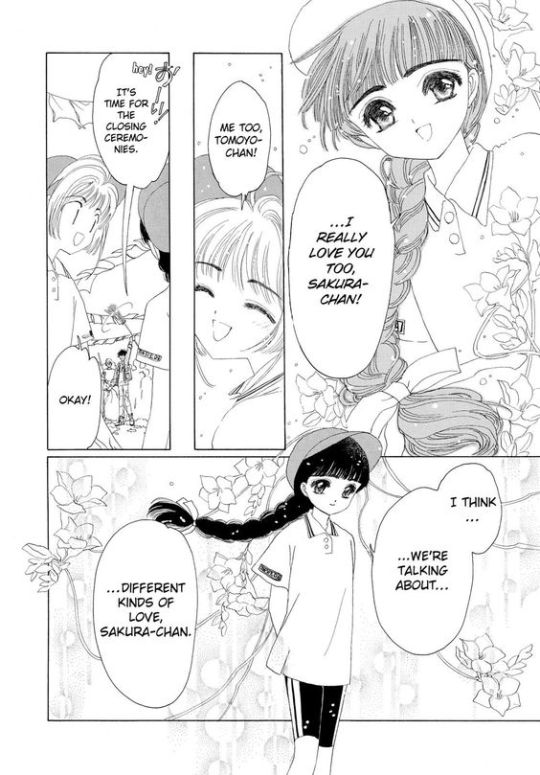
For this and so much more, I claim Tomoyo as part of the LGBTQ+ community. Watch Card Captor Sakura!

I'll share some panels (which are not related) that I like and that are a clear example of what I am discussing :3



16 notes
·
View notes
Text

Day 273: I think it can digging in the ground for tubers
434 notes
·
View notes
Text
Bocchi the rock! and Komi can’t communicate: Pretty privilege and social anxiety.
Bocchi the Rock! and Komi Can’t Communicate share the genres of slice of life and comedy. However, the difference is that Komi-san also includes romance, and they differ in terms of demographics: Bocchi the Rock! is a seinen, while Komi-san is a shonen. In both, the story revolves around a schoolgirl who struggles with social anxiety, which makes it difficult for them to participate in many activities or make friends easily.
However, the protagonists don’t look alike in terms of appearance.

Hitori Gotou, from Bocchi the Rock!, is a schoolgirl who always wears the same outfit: her pink tracksuit and school skirt (not counting the maid episode - Komi-san has one too). She doesn't fit conventional beauty standards, unlike Shoko Komi from Komi Can’t Communicate. Komi is also a schoolgirl, but she has long legs, beautiful and shiny long hair, soft and fair skin, big eyes and she’s very feminine. In the series, people sometimes refer to her as a “city girl” or elegant. This highlights the concept of "pretty privilege" in Komi’s anime.

Shoko doesn’t talk; she always uses her sketchbook to write on. Her friends usually don’t fully understand her personality or the way she behaves (Tadano being the exception). Even so, people love her. They always try to talk to her, and she’s regarded as “the goddess of the class.” Everyone wants to be her friend simply because she is pretty.
On the other hand, Hitori has spent most of her life alone. Her classmates don’t seek conversations with her, and when they do, she struggles to speak, so they eventually leave. Bocchi tries to draw attention to herself by wearing items related to her interests, like bracelets and shirts, and even bringing her guitar to class. Eventually, Bocchi finds people who like her for her personality.

This isn’t to say one is better than the other, everyone can have their favorite! I like both, and I love Komi and Bocchi!
Watch Bocchi the Rock! and Komi Can’t Communicate! :3 <3

10 notes
·
View notes